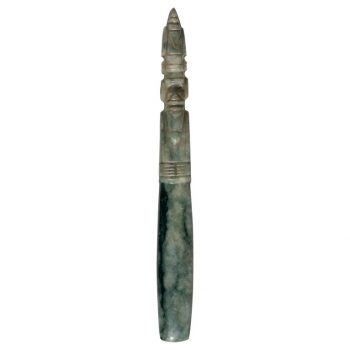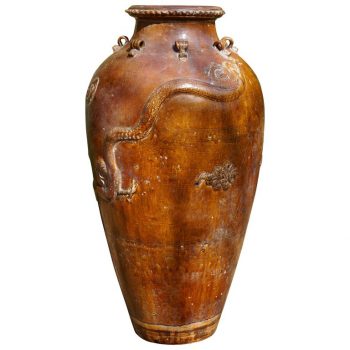Description
Tang Dynasty Terracotta sculpture of a fat lady
This stunning lady wears her hair in an elaborately styled coiffure. A remarkable amount of the original pigment that once decorated this work remains intact. Such women may represent wives, princesses, or attendants. Their beauty inspires us as we are transported back to another time. This gorgeous sculpture has been to the next world and returned to our modern era to tell us her tale. She speaks of the enormous wealth and sophisticated culture of the T’ang Dynasty, one of the greatest periods of artistic creation in human history. Although she speaks of the past, this lady in waiting continues to amaze us in the present with her unmatched beauty and sculptural refinement
Measures: Height: 11.5 Inches. 12.3 Inches with included wood stand.
Condition: Repair to neck. Otherwise; Excellent
It was during the T’ang Dynasty that China’s outstanding technological and aesthetic achievements opened to external influences, resulting in the introduction of numerous new forms of self-expression, coupled with internal innovation and considerable social freedom. The T’ang dynasty also saw the birth of the printed novel, significant musical and theatrical heritage and many of China’s best-known painters and artists. The Dynasty was created on the 18th of June, 618 AD, when the Li family seized power from the last crumbling remnants of the preceding Sui Dynasty. This political and regal regime was long-lived, and lasted for almost 300 years. The imperial aspirations of the preceding periods and early T’ang leaders led to unprecedented wealth, resulting in considerable socioeconomic stability, the development of trade networks and vast urbanisation for China’s exploding population (estimated at around 50 million people in the 8th century AD). The T’ang rulers took cues from earlier periods, maintaining many of their administrative structures and systems intact. Even when dynastic and governmental institutions withdrew from management of the empire towards the end of the period – their authority undermined by localised rebellions and regional governors known as jiedushi –the systems were so well- established that they continued to operate regardless. The artworks created during this era are among China’s greatest cultural achievements. It was the greatest age for Chinese poetry and painting, and sculpture also developed (although there was a notable decline in Buddhist sculptures following repression of the faith by pro-Taoism administrations later in the regime). It is disarming to note that the eventual decline of imperial power, followed by the official end of the dynasty on the 4th of June 907, hardly affected the great artistic turnover. During the Tang Dynasty, restrictions were placed on the number of objects that could be included in tombs, an amount determined by an individual’s social rank. In spite of the limitations, a striking variety of tomb furnishings – known as mingqi – have been excavated. Entire retinues of ceramic figures – representing warriors, animals, entertainers, musicians, guardians and every other necessary category of assistant – were buried with the dead in order to provide for the afterlife. Warriors (lokapala) were put in place to defend the dead, while horses/camels were provided for transport, and officials to run his estate in the hereafter. Domestic servants and attendants were also included, however, and it is to this category that the current pieces belong. During the Tang Dynasty, restrictions were placed on the number of objects that could be included in tombs, an amount determined by an individual’s social rank. In spite of the limitations, a striking variety of tomb furnishings, known as mingqi, have been excavated. Entire retinues of ceramic figures – animals, entertainers, musicians, guardians – were buried with the dead in order to provide for the afterlife. Of the various types of mingqi, perhaps none are more charming than the beautiful sculptures of elegant female courtiers. These gorgeous sculptures represent the idealized woman of the T’ang Dynasty. This sophisticated lady provided eternal companionship for her lord throughout the afterlife. We can imagine her gracefully dancing or singing a poetical song, two very popular customs for courtiers during the T’ang Dynasty, considered a golden age of Chinese culture. Such ladies are described in the numerous love poems written during this era, the greatest outpouring of poetry in Chinese history.
AVANTIQUES is dedicated to providing an exclusive curated collection of Fine Arts, Paintings, Bronzes, Asian treasures, Art Glass and Antiques. Our inventory represents time-tested investment quality items with everlasting decorative beauty. We look forward to your business and appreciate any reasonable offers. All of our curated items are vetted and guaranteed authentic and as described. Avantiques only deals in original antiques and never reproductions. We stand behind our treasures with a full money back returns if the items are not as described.
Please also consider Avantique’s antique and ancient Asian Art Collection of Han Dynasty, Tang Dynasty, Ming Dynasty, Qing, and Republic period items to complete your home and office decorations with class. Avantiques has Asian pottery, terra cotta, bronze, and paintings to complement your collection. We strive to collect the highest quality Asian antiquities in exceptional condition.





